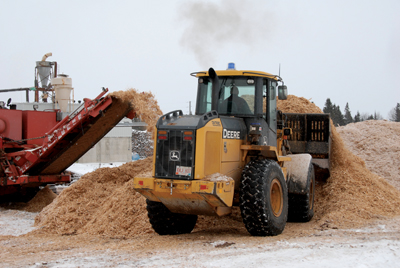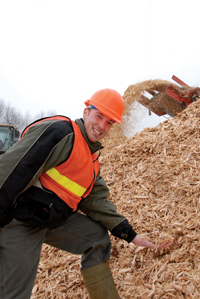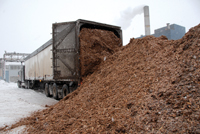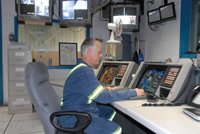
Feeding Frenzy
April 22, 2010
By Bill Tice
The boiler at Kruger Inc.’s Corner Brook Pulp and Paper (CBPP) mill in western Newfoundland has a big appetite for biomass – 713 tonnes/day to be precise.
The boiler at Kruger Inc.’s Corner Brook Pulp and Paper (CBPP) mill in western Newfoundland has a big appetite for biomass – 713 tonnes/day to be precise. That’s the amount of fuel it needs to generate the steam required to dry the mill’s production from its two operating paper machines, heat the mill buildings, and feed a power plant that drives a co-generation turbine operating at 7 to 10 MW. The mill generates 363 tonnes/day of biomass fuel on its own, leaving a shortfall of 350 tonnes/day that has to be sourced from outside suppliers.

|
| A John Deere 544 front-end loader moves wood fibre from the Morbark 4600 around the Major’s Logging yard and loads trucks destined for the Corner Brook Pulp and Paper mill.
|
In most forest products producing regions of Canada, that wouldn’t be an issue, as bark and shavings from local sawmill production could make up for any shortfall in biomass from the pulp and paper mill’s own wood room. But in Newfoundland, the sawmill industry, like the paper producers, has been hit extremely hard by the latest downturn in the economy. Today, the province has only three major sawmills operating, and two of them are a long way from CBPP. Despite the distances – 117, 385, and 502 km from CBPP’s gates – the mill sources pulp chips and small volumes of biomass from all three. But on the biomass front, the long trek makes for some expensive power.
That’s where Major’s Logging in Deer Lake, Newfoundland, comes into the picture. The long-term family business that has logged for CBPP for over 12 years has its offices, shop, and yard just 45 minutes from the mill. It also had a wood supply that needed to be used up: remnants from a sawmill it recently closed in Cormack, Newfoundland, which is just north of the Deer Lake site. Plus, it stores and grinds a large inventory of CBPP-owned roundwood that is suitable for biomass. What it all adds up to is some extra work to keep the key employees at Major’s Logging on the payroll during slow times in the regular harvesting cycles, and a steady and secure supply of biomass for CBPP.
 |
| Dean Major checks the quality of the ground biomass that will be sent to Corner Book Pulp and Paper.
|
“We have 36,000 cubic metres of roundwood at the Major’s Logging yard right now,” explains Bruce Coombs, an operations superintendent at CBPP who is responsible for a number of fibre-related duties, including chip and biomass supply for the mill. “Half of that wood is from our regular harvesting operations. The other half is wood with no home. It was pulp wood and fuel wood that was harvested by sawmills, but with the reduced paper production we are experiencing right now, there was no market for it, so we bought it for fuel wood.”
Coombs says that some of the wood has been in the logging company’s yard for a year. But he adds that with roundwood being used for fuel, “it can be beneficial” if you can let it dry out, so stockpiling it is not an issue. “The key is to keep it as roundwood until you are ready for it,” Coombs advises. “It will absorb moisture fairly quickly once you grind it, so for the most part, we have Major’s supply us with just-in-time delivery.”
That just-in-time delivery is achieved with a 2004 Morbark 4600 that has well over 8,000 hours on the clock, and several truck and walking floor trailer combinations owned by Major’s that will make up to 60 trips a week between the yard and CBPP. “We have had the Morbark here in the yard for over two years now,” says Dean Major, who works at the company with his brother Desmond, sister Laura, and father, Darcy. “We run it one shift, five days/week, and the main activity for it is grinding up roundwood for Corner Brook Pulp and Paper.”
Tag Team
The grinder is teamed up with a Tanguay loader that feeds the roundwood into the Morbark. The pair moves around the 15-acre Major’s Logging site as needed. The resulting fibre from the grinder is then moved to the trailer loading area by a John Deere 544 front-end loader, which also loads the trailers.
 |
| Corner Brook Pulp and Paper sources wood fibre for its pulp and energy needs from three sawmills in Newfoundland. This load travelled more than 500 km from Sexton Lumber.
|
Dean says that the biggest challenge they face is volume. “We produce in excess of what the mill needs,” he explains. “That can be a good thing though, as it provides us with a ‘surge pile’ so that we can optimize the product. The Corner Brook mill wants a variety of products, not just 100% of the same thing. They want a mix that will keep the boiler fed and give them the level of heat they require. So for us, it is key to manage our production in a way that gives us enough of the right mix in the surge pile to provide them with exactly what they need – not too dry or too wet, and the right size. They have been really pleased with the smaller sized product that we have been able to produce because it flows better and that means improved material handling for the mill.”
The head mechanic at Major’s, Duane McCarthy, along with Desmond Major, have spent many hours tweaking the Morbark grinder to handle its diet of predominantly roundwood. “The machine was originally designed to process bark and debris wood, so we had to make some modifications, mainly with the inserts on the drum, which we call teeth,” says McCarthy. “The teeth just weren’t aggressive enough, so we tried a few different types before finally going to feller buncher teeth. We originally tried some from one of our own bunchers that was here in the yard. We started out with just bolting the teeth on, but they turned too much, so we went to welding them to a block.”
That worked fine in the winter with green wood and when everything was frozen, but Desmond says that when things heated up in the summer, the steel melted on the buncher teeth. At that point, they saw a magazine ad for Quadco inserts that were made for a horizontal grinder. “We thought we would try them,” adds Desmond. “They were too tall and were hitting the anvil, but we were able to work with Quadco on a customized version that is shorter. They were working well until we tightened up the tolerances on the Morbark during routine maintenance. At that point, they started hitting the anvil again, so we asked Quadco to take another quarter inch off the length.”
Eventually, Major’s went with a combination of 10 customized inserts from Quadco and eight of the original Morbark inserts. It’s a combination that McCarthy says provides the best combination of product quality and cost effectiveness. “This combination works for about 90% of the wood we process, but we will have to change things up for some species or sizes,” he says. “For example, we tried to run some small diameter spruce, and it was getting jammed up and wouldn’t feed right, so it wasn’t very efficient. For this, and wood that is more brittle, we have to go with all Quadco teeth.”
Finding the Metal
Another project that Major’s Logging is working on is a wood waste diversion project between CBPP and the City of Corner Brook. The city wanted to divert wood material from the municipal landfill, and CBPP agreed to complete a trial to process the wood waste into hog fuel for the mill. This required another modification on the Morbark, which included adding a magnetic roller and two pans beneath the machine’s output belt. The magnetic roller catches any steel before it reaches the fibre pile. The steel is then dropped to the trays. “It has worked well for us,” says Dean, adding that the system has removed all kinds of foreign matter, including nails, bolts, doorknobs, and other small metal construction debris. The biggest piece of steel they have had go through the machine was a hammer head. “That did the most damage,” says Dean. “But the machine is designed for easy parts replacement, so we were able to get it up and running again fairly quickly.”
As for the waste diversion project numbers, they already know the Morbark is not as productive when processing urban waste as compared to roundwood. The main issue has been the lack of effective sorting of the waste wood and elimination of large metal contamination. “We have a Multi-dat box on the machine, which is tied into computers at the pulp mill,” says Dean. “It measures the machine’s uptime. We know when working in our yard on roundwood our utilization rate is at about 84%. When working at the landfill, we are generally at a utilization rate that sits just below 50% due to the problems with sorting and the larger pieces of metal.”
Core Business
In addition to the grinding work Major’s completes for CBPP, it handles logging for the pulp and paper producer, which Dean says is typically within a 100 km radius of the mill. The wood is all on CBPP Limits, and the logging plans are provided to Major’s Logging by CBPP. Major’s sorts for pulp logs, saw logs, and biomass logs, but Dean says that 85% of what they harvest for CBPP is pulpwood that they deliver to the mill’s wood room as roundwood.
 |
| Shift engineer Sheldon Rogers keeps an eye on things from the steam plant and cogeneration control room at Corner Brook Pulp and Paper. |
Major’s has a complete fleet of logging gear for cut-to-length operations, including a John Deere 2054 with a LogMax 6000 head, a Timberjack 608 with a Waratah head, and a pair of Tigercat 845 models – one with a LogMax 5000 head and the other with a Waratah 616 head. It also runs a Tigercat 822 feller buncher, a Tigercat 1065 18 tonne forwarder, and a Valmet 890 forwarder.
Dean says that logging is still the main thrust of the business, but he has no complaints when it comes to processing biomass. “It has been really good for us during this downturn in the economy,” he says, adding that the biomass processing part of the business is probably here to stay as companies start to rely more on biomass to meet their power needs. CBPP’s Coombs couldn’t agree more. He says that with biomass, the pulp and paper mill is now only sourcing 10 to 15% of its thermal energy from fossil fuels. “We have drastically reduced the use of fossil fuel in our production process. For our entire mill operation, we have gone from using 42 million litres of oil annually in 2004 to under 7 million litres today,” he notes. “That has provided us with a dramatic reduction in the litres of oil used per finished tonne of paper.”
Print this page